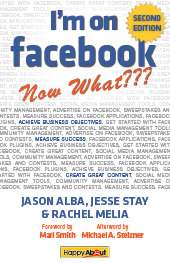 By Bill Doerr
By Bill Doerr
Sales and Marketing Editor
Bill's section is brought to you by qAlias
15 Second Executive ‘Speed Read’
Social Networking is a long-established mechanism for connecting with other people.
In days gone by, this meant anything from leaving a painting in a cave to being an elite member of a society’s ‘blue book’. Today, it’s more likely to mean a membership on either LinkedIn or Facebook.
What these latest social networks foster are the quantity of connections. But, as some point out, they may do so at the expense of the quality of the relationships they offer.
While no single social network is a perfect solution for everyone, a relatively new entrant to the social networking scene is Perfect Networker.
This site qualifies as a social network, but it is different. Why? The mission and passion of the founders is to teach . . . to teach the members who use it . . . how to build both high quality relationships as well as a significant number of valued connections.
Glenn Garnes, Mac Cassity and Ken Rochon are the founders of Perfect Networker – a new online community that is passionately committed to:
1) growing new and valued relationships
2) generating referrals, and
3) building revenues for an individual’s practice or business
for the people who are members of this young but growing online community.de
THE HISTORY
Glenn Garnes, an attorney by training and now a founder and key catalyst of Perfect Networker, shared some time with me recently to update me on the organization he helped to create.
Like many things, Perfect Networker evolved out of a sense of frustration with the limitations certain local business networking groups seemed to create for many people as well as the founders of Perfect Networker.
“Many business people are attracted to the notion of networking, but find many local groups are more focused on the mechanical rules of engagement than on the mission they were intended to achieve. We wanted to change all that with Perfect Networker”.
Glenn, Mac and Ken learned that networking has a tarnished image among many who are new to it because of a lack of education about what networking really is and how to network effectively with others. “It’s one thing to say, “There’s a plane” and quite another to actually get into it, fly it off the runway and level off safely at 39,000 feet”.
This inspired them to envision an intentional community of people who would be able to develop quality relationships with others and, as a result, be more refer-able themselves.
This immediately suggested a missing element in other networking organizations – despite their protests to the contrary: ‘Education and Training’ . . . in the art and science of how to build relationships, referrals and, as a result, revenues for the networker’s business or professional practice.
Glenn Garnes, who was a successful ‘rainmaker’ for his law firm, knew firsthand the power and value of networking in an offline environment. Ironically, what he did to grow his practice and revenues was also the reflection of his true passion and calling – to connect people with others to foster mutually beneficial relationships.
In 1999, Glenn became interested in the potential value of the internet as a medium for business promotion. In fact, he created various niche websites themed around ‘health and wellness’ and learned how to use them to sell ‘eyeball space’ on his sites to advertisers who wanted quality time with a select audience of qualified prospects.
That experience convicted him (please, no lawyer jokes, OK?) of the potency of the internet as an online medium for connecting interested parties with one another. So it’s not surprising that he began to think of how to use it to attract and cultivate valuable relationships with others. That, along with the input of his co-founders, lead to the eventual birth of the Perfect Networker website and online community.
THE PERFECT NETWORKER SITE and COMMUNITY
Ted Leavitt of
That’s why I asked Glenn the obvious question: “Why Perfect Networker . . . given the prevalence and extensive market penetration of alternative sites like LinkedIn, Facebook, etc.? In other words, what’s the angle that makes your site viable alongside all the existing players on the the social networking field?”
 Glenn replied, “Bill, on a scale of 1 – 10, where 10 means ‘outstanding’ and 1 means ‘ho hum’, how do you think most business people rate the value they’re receiving from these sites? Mind you”, he said, “I’m on LinkedIn myself and use it a lot. I think it’s fantastic for what it does. But not everyone who signs up for such a service is able to use it effectively and benefit profitably from it for their business or practice.”
Glenn replied, “Bill, on a scale of 1 – 10, where 10 means ‘outstanding’ and 1 means ‘ho hum’, how do you think most business people rate the value they’re receiving from these sites? Mind you”, he said, “I’m on LinkedIn myself and use it a lot. I think it’s fantastic for what it does. But not everyone who signs up for such a service is able to use it effectively and benefit profitably from it for their business or practice.”
So what is the justification for Perfect Networker to co-exist with the ‘big boys’ like LinkedIn and Facebook?
“Simple. We designed it, from the start, to create a truly valuable experience for people who become our members.”
I asked Glenn, “How do you do that?” Glenn indicated there are several keys . . .
Key #1: Relationships Before Transactions
The most notable element of Perfect Networker is the philosophy that recognizes the truth that outstanding networkers always seek relationships before transactions.
Key #2: Training and Development
The second element is the extensive training that Perfect Networker members receive in ‘how to’ build mutually beneficial relationships. There’s a Referral University that offers various documents, audio and video to support the development of each member’s skills so they can become viable, contributing members of this online community.
Key #3: A Committed Community
The third element is the online community itself. If ‘water seeks its own level’ then the founders are attracting other people who, like them, passionately embrace the philosophy that cultivating mutually beneficial relationships is the key to networking effectively.
Key #4: An Open Connection Architecture
This element isn’t unique, but it is valuable. While some social networking sites restrict access to other members of their communities, Perfect Networker actively encourages this by making it extremely easy to find other ‘like-minded’ and/or ‘potentially valuable’ people to connect with online.
“In the end,” said Glenn, “a social network – be it online or offline, is simply a means to an end . . . much like a highway . . . it can connect you with all sorts of wonderful places and people . . . but you need to know how to use that highway . . . you need to know where you want to go . . . you need a means of transportation to make the best use of it. In short, just because a social network exists doesn’t necessarily mean you’ll be able to use it to get wherever you want to be going . . . in your life or your business”.
He’s right.
Glenn, Mac and Ken are creating a truly unique (remember the definition?) online community here. It’s young. It’s growing. It will have some ‘pains’ as it grows. That’s to be expected.
What I didn’t expect (but find extremely heartening!) is that they really and truly get ‘it’.
They understand the secret to realizing value from any social network is to be a good citizen of that community, pro-actively reach out to others and seek to build relationships before transactions as a way to build revenues. Their site reflects this. Their actions support it. They are truly practicing what they’re teaching to their members. Refreshing!
Do yourself a favor and check it out for yourself. I think you’ll be as pleasantly surprised at this nascent undertaking in the growing social networking arena as I am.
About Perfect Networker
Founded by Glenn Garnes, Mac Cassity and Ken Rochon, this site helps people grow revenues in their business and value in their lives by focusing on building valuable relationships with others by design, not accident. To learn more go to: www.perfectnetworker.com or call Glenn Garnes at: (800) 306-6488.
Bill Doerr, CCO of SellMore Marketing, LLC is the creator of The Preferral Prospecting System™,
The Expert Directory™, The Client Machine™ and The Ultimate Client Development System™.
Bill uses these services to help service providers build their business by leveraging relationships and generating more introductions to new business. You can reach Bill by phone at: 860-798-6964, online: www.sellmoremarketing.com or www.getnewclientsnow.com by email: billd@sellmoremarketing.com or through the TNNW Blog: http://thenationalnetworker.blogspot.com
Forward/Share This Article With Colleagues And Social Media:




















